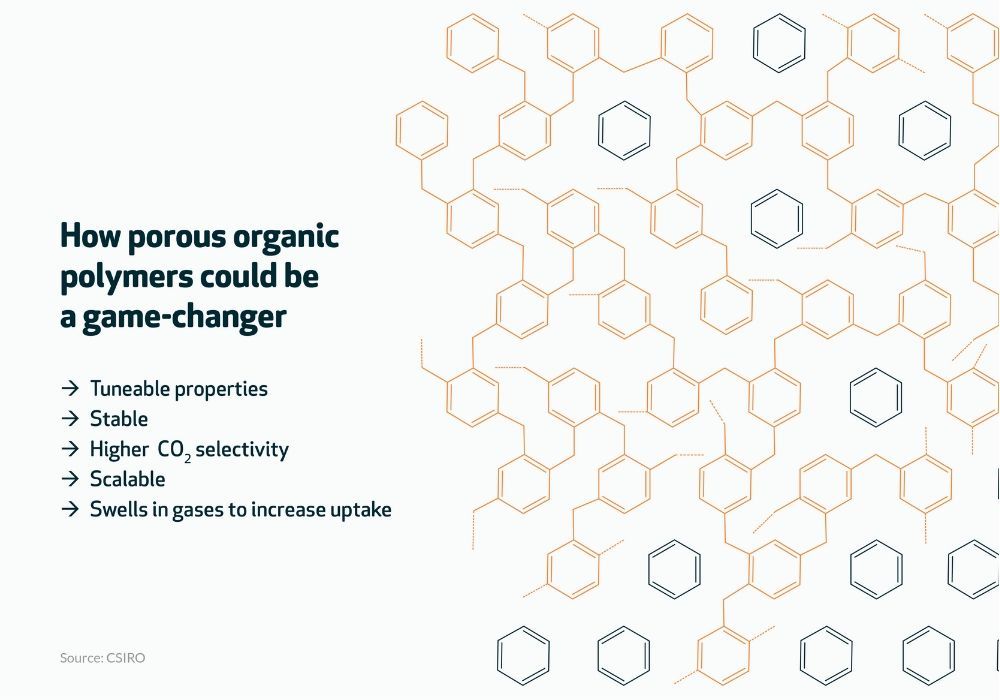The Race to Zero Emissions Through Carbon-Capture Technology
Innovative new materials have potential applications in the oil and gas sector and beyond.
As the world grapples with the reality of climate change, a growing number of scientists are focusing on one potential solution: carbon capture.
“It’s one of the hottest research topics in the world right now,” says Dr Colin Wood, research scientist at CSIRO. “A lot of really clever groups are looking at this at top institutes all around the world.”
Until recently, the science of capturing CO2 from industrial processes has remained unchanged. “The main way that carbon capture has been done for the past 50 years is by using liquids to capture the CO2,” Wood explains. “The CO2 can either dissolve in those liquids or react with those liquids.”
But as the effects of climate change become more pronounced, the research field is expanding. “There’s now people thinking about solid materials for capturing CO2, too,” says Wood.
He continues: “The benefit of solids is that often the rate of CO2 capture can be significantly higher. Not having to handle liquids can also be an advantage because handling liquids requires pumping systems and the like.”
However, solids have their drawbacks. “Regeneration can be more challenging because, in order to release the CO2, the material has to be heated in the same vessel where it is captured, which requires two sorption columns of the material.”
Possible alternatives
Wood and his team are beginning to research hybrid materials for carbon capture. “We take the best of the liquid components, combine it with the best of the solid components, and try to solve the problems,” he says.
One exciting area of work is on so-called ‘porous liquids’. “These are contrary to intuition, because liquids typically occupy the volume in which they are contained, like the conventional liquid amines used to date for capturing CO2,” notes Wood. “However, porous liquids retain the permanent, well-defined porosity of solids with the fluidity of liquids.”
There are various ways to achieve this, and Wood says there are many groups around the world exploring these materials. “The research is early-stage but offers promise.”
The CSIRO team is also developing ‘liquid amine particles’. “We’re taking a liquid, and we’re locking it into a particle format,” Wood explains. “These liquid amine particles are at an early stage but offer great potential. We’ve not applied them to industry yet, but we’ve certainly done a lot of testing of those materials under industry conditions.”
Another advance is the development of porous organic polymers. “We generate our material from waste polystyrene, so it’s an inexpensive and scalable approach,” says Wood. “We perform some chemical transformations, and we generate materials with 0.5nm pore space within the material.”
He adds: “Every single atom in that material is a surface. So, with a teaspoon of this material, you can get surfaces the equivalent of a soccer pitch. That’s because all of the walls in the material are atomically thick. So, you’ve got all that surface area to absorb CO2 onto.”
While the continued growth of carbon-capture research is promising, Wood points out that much of the current science is inherently limited. “We’ve seen an explosion of publications on materials for CO2 capture, but a lot of the time they’re focusing on pure CO2 streams and not real-world, where you’ve got all sort of other things that’s going to affect the performance,” he says.
For example, the composition of real-world gases that contain CO2 varies widely. “The composition of the gas captured at a coal-fired power station is very different to the composition of the gas that you’d get, say, at a cement factory,” he says.
To address this research issue, the CSIRO has built a rig at its facility in Perth that is capable of testing carbon-capture materials with a range of potential gases. “We can very accurately dial in the gas composition and test materials under those actual conditions, which is a really powerful tool,” says Wood.
He believes the coming years will see significant advances in the deployment of carbon-capture solutions. “The development of materials that can capture CO2 under industry relevant conditions is advancing quickly, with examples including porous polymers and our own ‘liquid amine particles’, both of which are scalable and cost effective, which is key for large-scale deployment,” he says.
And it’s likely that the oil and gas sector will lead the way. “Over recent decades, the oil and gas industry has been one of the leading developers of large-scale CO2 capture, which is now routine for oil and gas processing,” says Wood. “This has been achieved using liquid amines.”
He adds: “As the concentrations of CO2 in oil and gas fields increase, there is a need for new materials that can offer higher CO2 uptake. However, the infrastructure and know-how for applying new materials is already in place with flow-based CO2 capture systems and large-scale columns which contain solid sorbents for dehydrating the gas.
“Everything is in place for deploying new materials, providing they can meet the strict requirements of performance and scalability.”
AOG 2021 will run 10-12 March at the Perth Convention and Exhibition Centre.
To stay up to date, subscribe here.
You may also like
-
Stay up to date with the latest news, industry insights and AOG Energy updates.
- Subscribe

